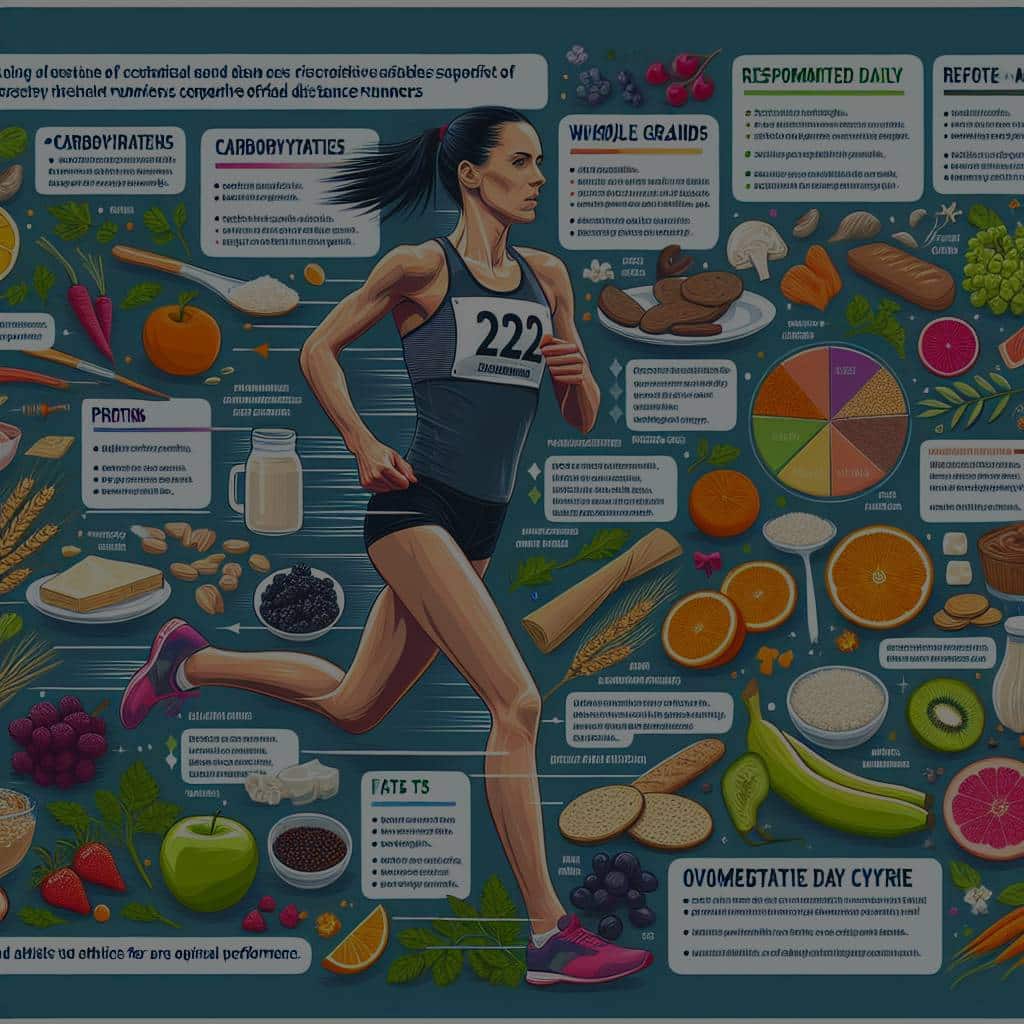What Are the Specific Nutritional Needs for Competitive Female Distance Runners?

In the world of sports, nutrition plays a crucial role in an athlete’s performance. This is especially true for competitive distance runners, who are required to sustain high energy levels for extended periods. But what does this mean for the female athlete? Are her nutritional needs the same as her male counterparts? Let’s dive deep and understand the specific nutritional needs of competitive female distance runners, drawing knowledge from reliable sources such as Google Scholar, PubMed, and CrossRef.
Understanding the Basics of Sports Nutrition
Before we delve into the specifics, it’s essential to have a clear understanding of sports nutrition. Good nutrition helps optimize athletes’ performance and recovery, allowing them to train more effectively and compete at their best. For distance runners, this means getting enough energy from the right sources, which mainly includes carbohydrates, fats, and proteins.
A lire aussi : How Can AI-Powered Motion Capture Improve Technique in Olympic Weightlifting?
Carbohydrates are typically the body’s primary source of energy. They are stored in the muscles and liver as glycogen, and then released into the bloodstream as glucose when the body needs quick energy. It is recommended that athletes get about 6-10g of carbohydrate per kilogram of body weight per day, depending on the intensity and duration of their training.
Fats serve as a secondary source of energy, especially during longer, low-intensity exercises such as distance running. They also play a vital role in maintaining healthy skin and hair, insulating body organs against shock, maintaining body temperature, and promoting healthy cell function.
En parallèle : What’s the Best Way to Implement Video Replay Analysis in Hockey Training?
Lastly, proteins are essential for repairing and building tissues, producing enzymes and hormones, and supporting a healthy immune system. Athletes may require a slightly higher protein intake than non-athletes to support muscle repair and growth.
The Impact of Gender on Nutritional Needs
While the basic nutritional needs remain the same for all athletes — carbohydrates for energy, fats for fueling longer workouts, and proteins for tissue repair and growth — it’s important to understand that female athletes have unique nutritional demands.
For instance, female athletes often require fewer total calories than male athletes due to generally lower body weights and muscle mass. However, they often require more iron, as women tend to lose more iron through menstruation. Iron is essential for athletes since it helps transport oxygen to the muscles, which is crucial for endurance sports such as distance running.
Tailoring Nutrition for Competitive Female Distance Runners
Now, let’s look at how these general principles apply specifically to competitive female distance runners. What adjustments or adaptations need to be made to maximize performance and recovery?
High-Carbohydrate Diet for Energy
Competitive female distance runners need a high carbohydrate intake to fuel their long, intense workouts. The recommendation is roughly 5-7g of carbohydrates per kilogram of body weight, although the exact amount will vary depending on the individual’s body weight and the duration and intensity of their exercise.
Adequate Protein Intake for Recovery
Protein is essential for recovery after workouts, and female distance runners should aim for about 1.2-1.4g of protein per kilogram of body weight each day. This can be achieved through a combination of foods such as lean meats, dairy products, eggs, and plant-based sources like beans and lentils.
Ensuring Sufficient Iron Intake
As mentioned earlier, female athletes often require a higher iron intake due to menstrual losses. Iron deficiency can lead to fatigue and reduced endurance, so it’s particularly problematic for distance runners. It’s recommended that female athletes get about 18mg of iron per day, which can be obtained from foods like red meat, poultry, fish, legumes, and fortified grains.
Balancing Energy Intake and Expenditure
Maintaining balance between energy intake (from food) and energy expenditure (from exercise) is critical for all athletes, but can be particularly challenging for female distance runners. This is due to the high energy demands of running combined with societal pressures to maintain a low body weight.
When energy intake is too low, it can lead to nutrient deficiencies, decreased performance, and health problems such as decreased bone density and menstrual dysfunction. On the other hand, excessive energy intake can lead to weight gain and reduced performance. Therefore, it’s important for female distance runners to find a balance that allows them to meet their energy needs without compromising their health or performance.
The Role of Hydration in Performance
Finally, let’s not overlook the importance of hydration. Dehydration can significantly impair performance and may lead to heat-related illnesses. Female distance runners should aim to start their runs well-hydrated and drink fluids at regular intervals during their runs to replace the water and electrolytes lost through sweat.
In the world of competitive sports, proper nutrition is just as important as training. Athletes, including female distance runners, need to ensure they’re getting the right nutrients in the right amounts to fuel their performance and support their recovery. Therefore, it’s crucial to have a good understanding of these nutritional needs, and to plan diets accordingly.
Nutritional Strategies to Address Menstrual Cycle and Energy Availability
One of the key challenges in sports nutrition, especially for female athletes, is understanding and addressing the changes in energy needs and nutrient absorption that occur throughout the menstrual cycle. Menstruation can affect the absorption of certain nutrients, such as iron, leading to an increased risk of iron deficiency, especially in endurance athletes.
Research articles from sources like Google Scholar, PubMed, and CrossRef indicate that energy availability tends to be lower during the luteal phase of the menstrual cycle (the second half, after ovulation). This lower energy availability can affect performance, particularly in sports like distance running that require sustained energy.
To address this, female distance runners should aim to increase their energy intake during the luteal phase. They should also pay close attention to their iron intake, as iron deficiency can lead to reduced endurance and performance. Regular iron supplementation may be needed, especially for those with heavy menstrual bleeding. An iron supplement should be taken along with a source of vitamin C to enhance absorption.
Hormonal fluctuations during the menstrual cycle can also affect fluid balance, increasing the risk of dehydration. Therefore, hydrating properly throughout the cycle, not just on race day, is crucial. Lastly, it’s worth noting that each woman’s menstrual cycle is unique. Individual assessment and tailored dietary strategies may be necessary, and guidance from a sports medicine professional or sports nutritionist can be invaluable.
The Risk of Relative Energy Deficiency in Sport (RED-S)
Often, in discussions about sports nutrition, the focus is on what athletes should eat. However, it’s equally important to highlight what can happen when they don’t eat enough. This is particularly true for female distance runners, who may be at risk of a condition known as Relative Energy Deficiency in Sport (RED-S).
RED-S, formerly known as Female Athlete Triad, is a syndrome that can affect any athlete, but is more commonly seen in those in sports where a low body weight is often incorrectly perceived as beneficial, such as distance running. This condition is characterized by low energy availability (with or without disordered eating), menstrual dysfunction, and low bone mineral density.
Low energy availability can be either intentional (due to dieting or disordered eating) or unintentional (due to high training volumes without adequate fueling). Regardless, the result is the same: the body doesn’t get enough energy to support both the demands of training and the functions necessary for health.
The consequences of RED-S can be severe, ranging from decreased performance to increased risk of injury, impaired immune function, and long-term health problems such as osteoporosis. Therefore, it’s crucial that female distance runners are educated about the risks of low energy availability and the importance of maintaining a balanced diet.
Conclusion
In the world of competitive sports, maintaining optimal nutrition is a cornerstone of performance and recovery. For female distance runners, understanding the specific nutritional needs associated with their physiology and activity level is key. This includes maintaining a high carbohydrate diet for sustained energy, ensuring adequate protein intake for recovery, and managing iron intake to avoid deficiency.
Moreover, factors such as menstrual cycle and energy availability require special consideration to ensure optimal performance. The risk of RED-S, potentially threatening both performance and overall health, highlights the importance of monitoring energy intake carefully.
With the aid of resources like Google Scholar, PubMed, and CrossRef, athletes and coaches can navigate these challenges by staying informed about the latest research in sports medicine and nutrition. By doing so, they can tailor nutrition strategies to meet the unique needs of female distance runners, ensuring that they are fueling their bodies appropriately for both health and performance.
